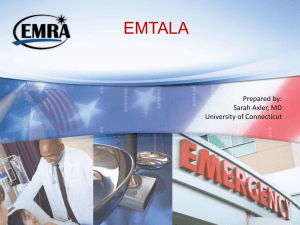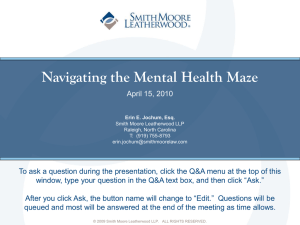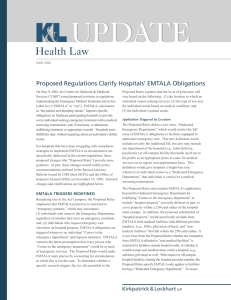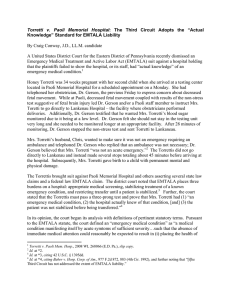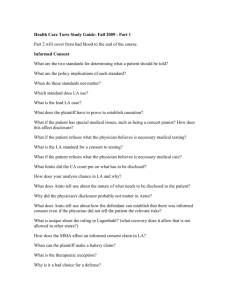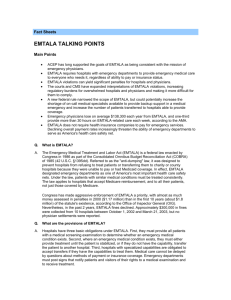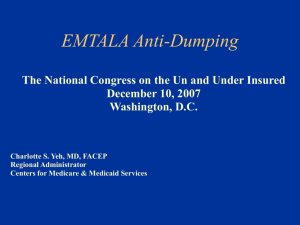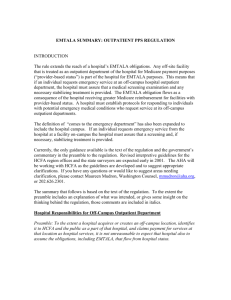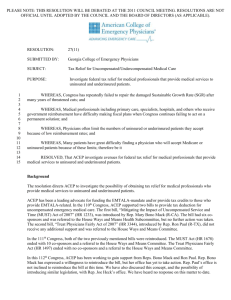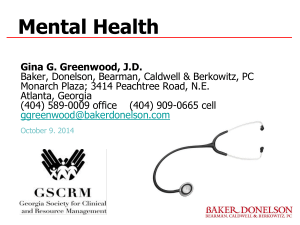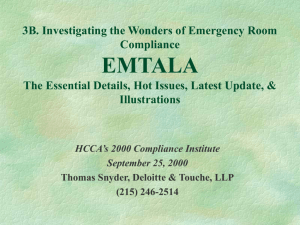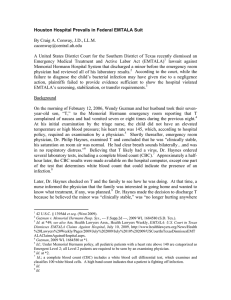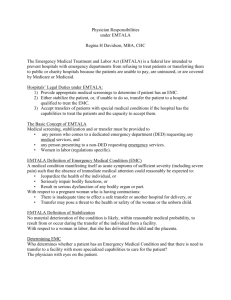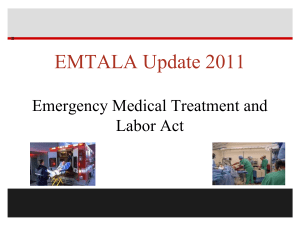EMTALA-Self-Learning-Packet-and
advertisement
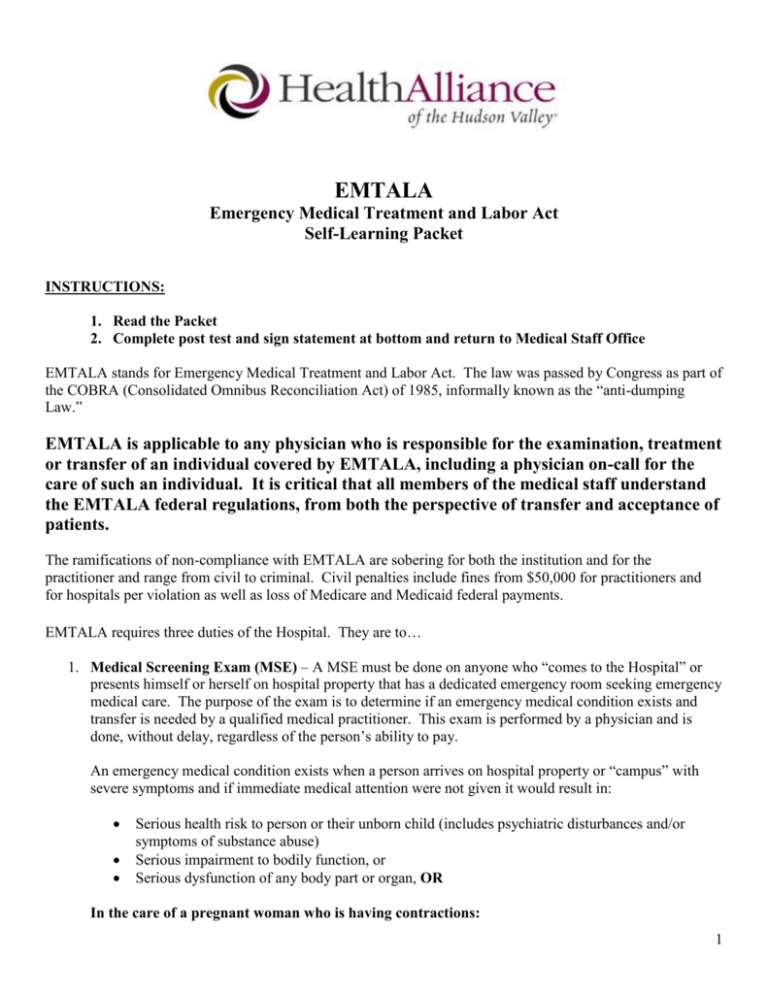
EMTALA Emergency Medical Treatment and Labor Act Self-Learning Packet INSTRUCTIONS: 1. Read the Packet 2. Complete post test and sign statement at bottom and return to Medical Staff Office EMTALA stands for Emergency Medical Treatment and Labor Act. The law was passed by Congress as part of the COBRA (Consolidated Omnibus Reconciliation Act) of 1985, informally known as the “anti-dumping Law.” EMTALA is applicable to any physician who is responsible for the examination, treatment or transfer of an individual covered by EMTALA, including a physician on-call for the care of such an individual. It is critical that all members of the medical staff understand the EMTALA federal regulations, from both the perspective of transfer and acceptance of patients. The ramifications of non-compliance with EMTALA are sobering for both the institution and for the practitioner and range from civil to criminal. Civil penalties include fines from $50,000 for practitioners and for hospitals per violation as well as loss of Medicare and Medicaid federal payments. EMTALA requires three duties of the Hospital. They are to… 1. Medical Screening Exam (MSE) – A MSE must be done on anyone who “comes to the Hospital” or presents himself or herself on hospital property that has a dedicated emergency room seeking emergency medical care. The purpose of the exam is to determine if an emergency medical condition exists and transfer is needed by a qualified medical practitioner. This exam is performed by a physician and is done, without delay, regardless of the person’s ability to pay. An emergency medical condition exists when a person arrives on hospital property or “campus” with severe symptoms and if immediate medical attention were not given it would result in: Serious health risk to person or their unborn child (includes psychiatric disturbances and/or symptoms of substance abuse) Serious impairment to bodily function, or Serious dysfunction of any body part or organ, OR In the care of a pregnant woman who is having contractions: 1 In adequate time to effect a safe transfer to another hospital before delivery; OR The transfer may threaten the safety of the woman or unborn child. A pregnant woman, experiencing contractions, is in true labor unless a physician, certified nurse midwife, or other qualified medical person acting within their scope of practice, certifies that after a reasonable time of observation the woman is in false labor. Therefore, any woman considered to be in active labor is unstable under EMTALA, preventing discharge or transfer unless the transferring hospital has absolutely no capability to deliver the baby safely. 2. Stabilizing treatment must be provided to stabilize the medical condition within the capabilities of the Hospital’s staff and facilities. If unable to stabilize an individual, the hospital must explain to the patient the risks and benefits of the transfer and obtain the patient’s consent. 3. Appropriate Transfer or admission The acceptable reasons for transfer would include: 1. The patient requires specialized care, not available at your hospital. 2. The patient or family requests the transfer (in this case the patient/family must also sign the InterInstitutional Transfer Form). The Hospital is not released from its EMTALA duty when a patient/family requests transfer. All the conditions of transfer must be met. Transfer is prohibited until the patient’s condition is stabilized, unless the conditions for transferring an “unstable” patient, as set forth below, are met. CMS defines “stable” as “No material deterioration is likely within reasonable medical probability, to result from or occur during the transfer of the individual from a facility or that the pregnant woman with contractions has delivered (including delivery of the placenta.)” A patient may be transferred when “unstable” only when: The patient requests transfer after being informed of the risks and benefits The physician certifies on the Inter-Institutional Transfer Form that the medical benefits outweigh the risks of transfer. For further information, please refer to the hospitals’ EMTALA POLICY 2 EMTALA POST TEST 1. True False Uninsured fines of up to $50,000 per violation may be imposed on hospitals and physicians for EMTALA violation. 2. True False The EMTALA law applies to any person who comes to the hospital campus or Emergency Department seeking medical care. 3. True False The Hospital may lose its Medicare certification for violation of the EMTALA law. 4. True False EMTALA protects persons against discrimination based on ability to to pay/insurance status, race, religion, sex, age or diagnosis. 5. True False If a person comes to the Hospital for care and says that he does not have any insurance, we do not have to treat him. 6. True False EMTALA is known as the COBRA or the Anti-Dumping Law. 7. True False If a person comes to the hospital lobby and states that he/she needs emergency medical care you would escort the person to the Emergency Department. 8. True False Women in labor are exempt from EMTALA. 9. True False Benefits and risks of a transfer must be explained to the patient and documented on the Inter-Institutional Transfer Form. 10. True False The EMTALA Law requires a MSE, stabilizing treatment and appropriate transfer if necessary. I have read, understand, and have had the opportunity to have my questions answered relative to EMTALA. Signature:______________________________ Date: Printed Name: 3
